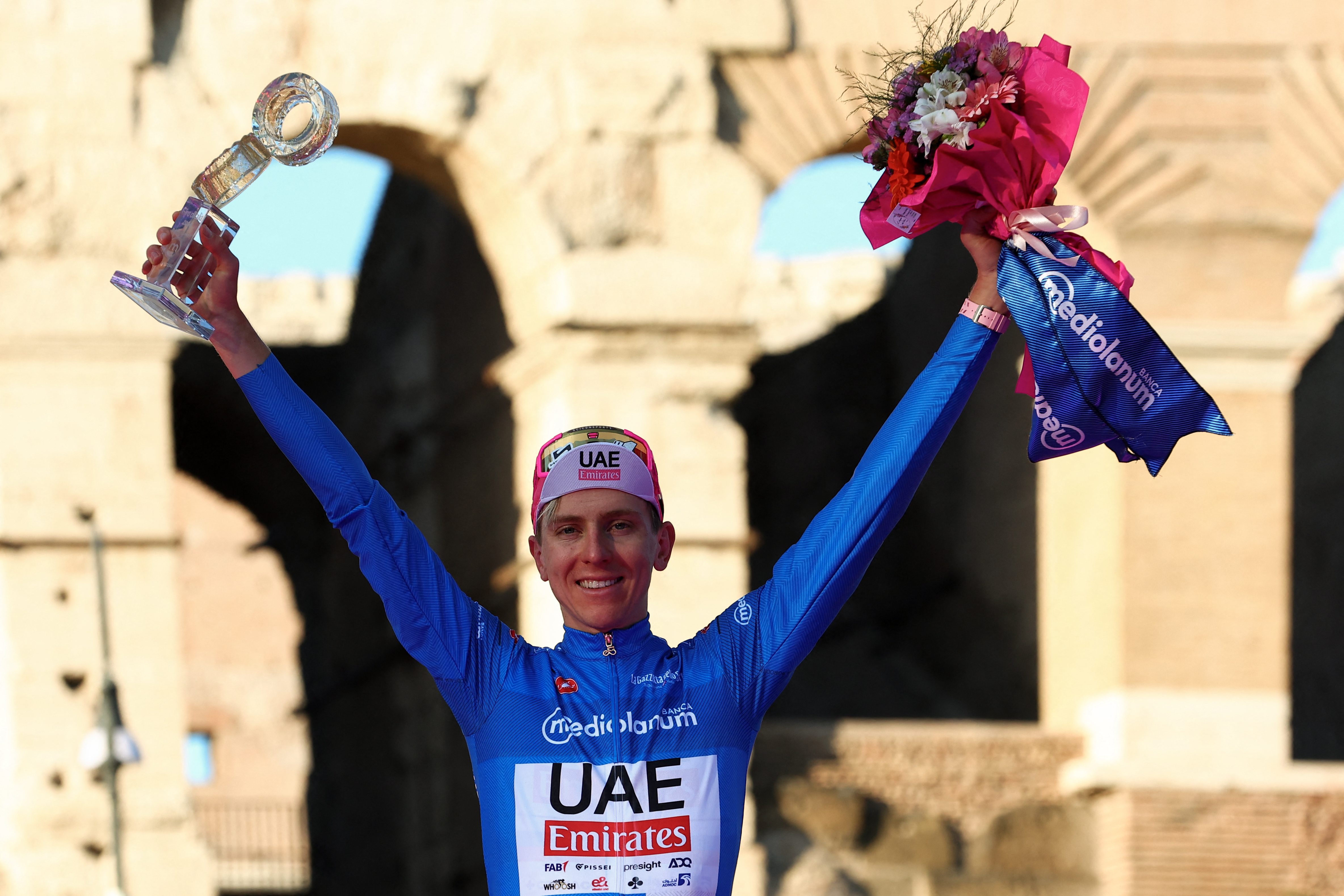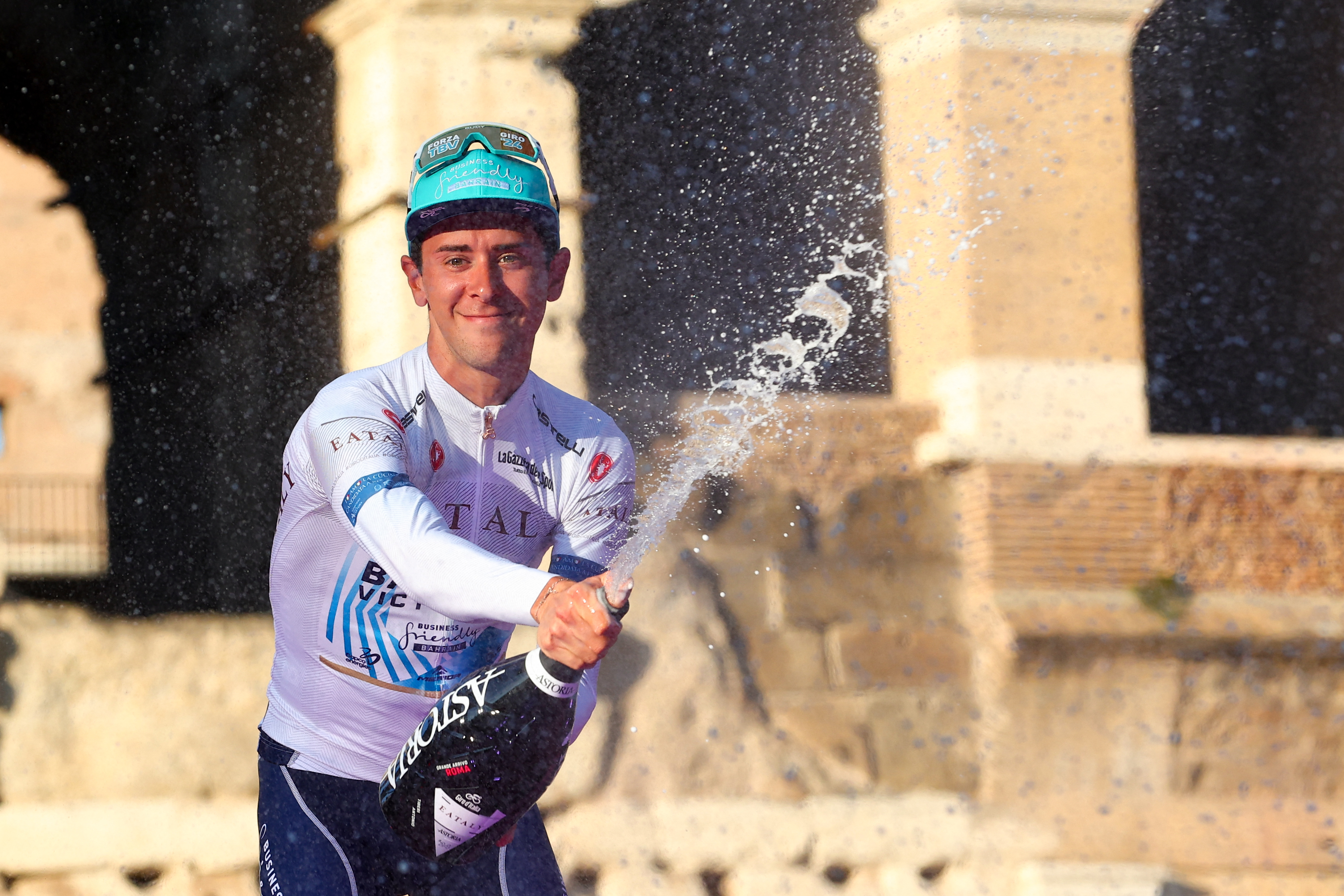What do all the Giro d'Italia jerseys mean? Pink, purple, blue and white explained
There are no polka dot or green jerseys in this race


If you're preparing to watch the Giro d'Italia as intently as we are, then you might be wondering what all the distinctive jerseys mean. Away from the 23 different teams, and the national champions, there are four more jerseys you need to keep your eyes on.
They are the pink (rosa), white (bianco), purple/cyclamen (ciclamino) and blue (azzurra). That is the leader's jersey, the young rider's jersey, the points jersey, and the king of the mountains jersey, respectively. There's no Tour de France green or polka dots here.
The jerseys are all worn by the leaders in those competitions, unless one rider holds two at once - in that case, the pink jersey takes priority, followed by the ciclamino, then the blue and white. That's why you will see riders who are not leading the competition in the colourful jerseys.
Jersey colour | Classification |
Pink/Rosa | General classification, overall leader |
Purple/Ciclamino | Points |
Blue/Azzura | Mountains |
White/Bianca | Best young rider |
Giro d'Italia jerseys
General classification - pink jersey

Tadej Pogačar on the podium as the general classification winner at the Giro d'Italia 2024
First up is the maglia rosa, the pink jersey, the kit worn by the leader of the general classification, the rider who has got around the route faster than everyone else. It is given to the rider who sits atop the GC at the end of every day, with the final one awarded with the Trofeo Senze Fine to the winner after the final stage.
It was introduced in 1931 and is pink because La Gazzetta dello Sport, the Italian sports newspaper which created the race, is printed on pink paper.
It is not as simple as getting round fastest cumulatively. Time bonuses are also on offer, with the top three men on each of the 18 road stages taking 10, six, and four seconds. Intermediate sprints on each road stage also offer bonuses of six, four and two seconds at Red Bull-sponsored bits.
In the event of two riders tying on time, the organisers will decide the standings based on fractions of a second measured in the race's time trials.
The latest race content, interviews, features, reviews and expert buying guides, direct to your inbox!
The pink jersey is sponsored by Iuman, an Italian underwear company. It appears to have splotches of pink across it this year.
The riders who have won the jersey the most are Eddy Merckx, Fausto Coppi and Alfredo Binda, who all took the coveted prize five times. The closest to that feat in recent years was Vincenzo Nibali (Trek-Segafredo) who won twice, in 2013 and 2016.
Year | Winner |
2024 | Tadej Pogačar |
2023 | Primož Roglič |
2022 | Jai Hindley |
2021 | Egan Bernal |
2020 | Tao Geoghegan Hart |
2019 | Richard Carapaz |
2018 | Chris Froome |
2017 | Tom Dumoulin |
2016 | Vincenzo Nibali |
2015 | Alberto Contador |
2014 | Nairo Quintana |
Points - purple jersey

Jonathan Milan in the ciclamino jersey at the Giro
To be clear, the purple isn't purple, it's technically cyclamen, or ciclamino. This eye-catching kit is worn by the rider who has accumulated the most points over the stages.
Points on offer are weighted towards sprint stages, so flat or punchy stages offer more than summit finishes. An intermediate sprint on each day - apart from time trials - also offers points.
The 19 road stages of the race are separated into five difficulty categories with their own points weightings. On A and B category days, the top 15 score, while on others it is just the top 10.
A and B category: 50, 35, 25, 18, 14, 12, 10, 8, 7, 6, 5, 4, 3, 2, 1 points
C category: 25, 18, 12, 8, 6, 5, 4, 3, 2, 1 points
D and E category: 15, 12, 9, 7, 6, 5, 4, 3, 2, 1 points
Intermediate sprints: 12, 8, 6, 5, 4, 3, 2, 1 points
The jersey is sponsored by the Italian Ministry of Foreign Affairs and the Italian Trade Agency to promote the country under the banner of Made in Italy.
Year | Winner |
2024 | Jonathan Milan |
2023 | Jonathan Milan |
2022 | Arnaud Démare |
2021 | Peter Sagan |
2020 | Arnaud Démare |
2019 | Pascal Ackermann |
2018 | Elia Viviani |
2017 | Fernando Gaviria |
2016 | Giacomo Nizzolo |
2015 | Giacomo Nizzolo |
2014 | Nacer Bouhanni |
Mountains - blue jersey

Tadej Pogačar on the podium as the mountains classification winner at the Giro d'Italia 2024
The blue jersey, or maglia azzurra, is given to the rider who takes home the most points on classified climbs over the race; potentially the best climber in the race, or the most canny breakaway expert.
There are 54 classified climbs across the 21 stages and unlike the Tour de France in recent years, it is not normally the GC winner who takes home the mountains jersey. However, Tadej Pogačar did win both in 2024.
The mountain classification has appeared in the race since 1933 but a green was introduced in 1974. The jersey has been blue since 2012 to match the colours of the competition sponsor, the Milanese bank, Banca Mediolanum.
Climbs are separated into five different categories, from the Cima Coppi award to fourth-category. Since 2023, summit finishes on first category climbs will gain extra points. The Cima Coppi is the Finestre on stage 20 this year.
Cima Coppi: 50, 30, 20, 14, 10, 6, 4, 2, 1 points
First-category summit finishes: 50, 24, 16, 9, 6, 4, 2, 1 points
First-category: 40, 18, 12, 9, 6, 4, 2, 1 points
Second-category: 18, 8, 6, 4, 2, 1 points
Third-category: 9, 4, 2, 1 points
Fourth-category: 3, 2, 1 points
Year | Winner |
2024 | Tadej Pogačar |
2023 | Thibaut Pinot |
2022 | Koen Bouwman |
2021 | Geoffrey Bouchard |
2020 | Ruben Gurreiro |
2019 | Giulio Ciccone |
2018 | Chris Froome |
2017 | Mikel Landa |
2016 | Mikel Nieve |
2015 | Giovanni Visconti |
2014 | Julián David Arredondo |
Best young rider - white jersey

Antonio Tiberi on the podium as best young rider at the Giro 2024
The best young rider classification awards the white jersey. It is, in effect, the same as the pink jersey yet can only be won by those who were 25 or under at the start of the year - terrifyingly, that means you have to be born this century to win. The current iteration of the jersey was introduced in 2007.
It is sponsored by CONAD, an Italian supermarket chain.
Evgeni Berzin, Nairo Quintana, Tao Geoghegan Hart, and Egan Bernal are the only men to win the pink and white jerseys in the same year, though Damiano Cunego would have been eligible had the prize existed in 2004.
Year | Winner |
2024 | Antonio Tiberi |
2023 | João Almeida |
2022 | Juan Pedro López |
2021 | Egan Bernal |
2020 | Tao Geoghegan Hart |
2019 | Miguel Ángel López |
2018 | Miguel Ángel López |
2017 | Bob Jungels |
2016 | Bob Jungels |
2015 | Fabio Aru |
2014 | Nairo Quintana |
Other classifications
Super team
This is the teams classification at any other race. The top three finishers from each team are added up each day, and then added up across the 21 stages, to establish the best team overall.
Lowest accumulated time wins, and there are usually some big gaps in this competition.
Intermediate sprints
There are two intermediate sprints on each road stage, with both offering points towards this competition. It gives an opportunity to riders who spend a lot of time in breakaways, but might not win stages, to win a prize.
Points are awarded to the first five riders across the line – 10, six, three, two, and one.
Breakaways
The Fuga Pinarello prize is given to the rider who spends the most time in front of the peloton across the three weeks. Only breakaways of fewer than 10 riders are counted, and the move must cover more than 5km of racing.
Combativity
This is essentially the Giro d'Italia's version of the Tour de France's 'supercombativity' award, and is incredibly subjective. The race's organisers say: "By scanning a QR code broadcast live on TV and on official social channels, the public will choose the rider who best embodied the value of combativity: the one who never gave up, who attacked, who made the race more thrilling."
The winner gets a red number to ride with for the next day, and there is an overall winner at the end of the Grand Tour. It is sponsored by Sanmarco Informatica.
Fair play
Points are given to the squads which receive penalties across the 21 stages, and this is counted up over the race. The team with the least points wins. Simple.
Cima Coppi
The rider who crosses the highest point of the Giro d'Italia first is given the Cima Coppi, the prize named after Fausto Coppi, who won the race five times.
This year, the Cima Coppi is on stage 20 on the Colle delle Finestre.
MONTAGNA PANTANI
Another deceased Italian cycling great, Marco Pantani, is honoured by a separate mountain prize, the Montagna Pantani. It is given to the rider who tops another of the race's great climbs. This year, it's the Passo di Mortirolo on stage 17.

Adam is Cycling Weekly’s news editor – his greatest love is road racing but as long as he is cycling, he's happy. Before joining CW in 2021 he spent two years writing for Procycling. He's usually out and about on the roads of Bristol and its surrounds.
Before cycling took over his professional life, he covered ecclesiastical matters at the world’s largest Anglican newspaper and politics at Business Insider. Don't ask how that is related to riding bikes.
You must confirm your public display name before commenting
Please logout and then login again, you will then be prompted to enter your display name.